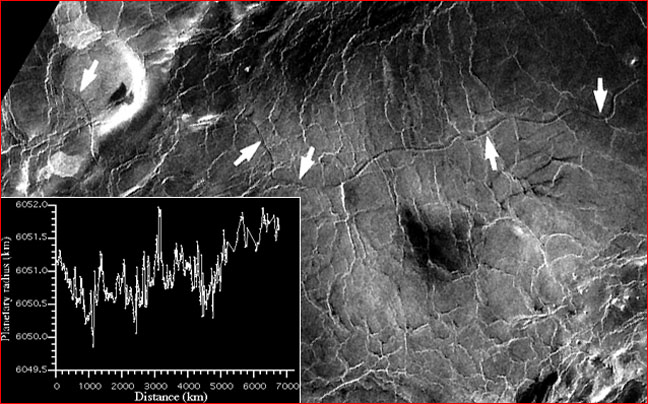
home •
about •
essential guide •
picture of the day •
thunderblogs •
news •
multimedia •
predictions •
products •
get involved •
contact

Caption: This Magellan Orbiter image shows a section of the “River Styx”
or Baltis Vallis sinuous “river” channel on Venus.
Inset is a topographical chart of Baltis Vallis, showing that it rises and falls some
2 kilometers in elevation along its 6,800 km length. A liquid cannot have carved this channel.
Inset credit: Profile of Baltis Vallis, the longest channel (from Komatsu and Baker, 1994).
“Baltis” is a Syrian word for the planet Venus.
pic of the day
archive
subject index
abstract
archive
Links:
Society for
Interdisciplinary
Studies
Feb 03, 2005
Venus and the River Styx
In his book, Venus Revealed, David H. Grinspoon comments on the image above:
“The vast volcanic plains that cover nearly all low-lying areas are the long-sought global ‘oceans’ on the surface of Venus–frozen oceans of basalt. One of the most astounding surface forms discovered by Magellan furthers the analogy: this ocean is fed by rivers! We see numerous thin, meandering channels, typically a mile wide and thousands of miles in length. The longest of these, Baltis Vallis, winds more than forty-two hundred miles over the plains [and might have been longer originally]. Baltis is longer than the Nile and thus can safely be called the longest river anywhere within several light-years of here. On Earth or Mars we would interpret such features as evidence of past or present running water. The analogy with structures carved by terrestrial water goes quite deep. We see fanlike river deltas, meanders, and bars, and places where streams have flooded their banks.
“…On Venus, where it is far too hot for liquid water, perhaps a stream of lava with the right chemical composition could flow like a river. We have had to use a lot of imaginative physics and chemistry to come up with a suitable model.
“…Topographical analysis of the flow paths produced a puzzling result: some of them seem to flow uphill! Since gravity is gravity on any planet, the ground in these places must have shifted since the time the rivers ran.”
Grinspoon’s commentary shows how strained the Earth-centered analogies become. There is little evidence of damage to the channel that would be expected from ground movements sufficient to cause kilometer height changes. And with all of the strange tributary channels we should expect to see a progressive widening of the main channel. But no widening is evident.
The channel is more simply explained as a surface cosmic lightning channel--a thunderbolt. In a high-energy plasma discharge, a powerful electromagnetic “pinch” effect can constrain the discharge channel to a constant width over vast distances. The discharge hugs the surface over hill and dale, responding to electrical forces instead of to gravity. Tributary channels tend to join the main channel near orthogonally. In fact Baltis Vallis shows many of the features seen in the Huygens probe image of a “river” on Titan dubbed the “airstrip.”
But it will take a revolution in human thought to break through the inertia of customary perception. Consider, for example, the comments of professor Victor R. Baker in his book, The Channels of Mars. First he writes, “The relatively recent discovery of alien landscapes poses many disturbing questions for a science grown complacent with the study of the familiar.” But then, on the very next page he writes: “...impact cratering and volcanism are the two processes dominating the surface histories of the terrestrial planets.” To see that this cannot be so, it is only necessary for the critically minded to look at pictures, and these are now available by the thousands.
So long as we cling to hoary geological myths, planetary surfaces will remain indecipherable. Disturbing and difficult questions will be overlooked, or “imaginative physics and chemistry” will pretend to answer them. The geology of Venus, like that of so many other bodies in space, cries out for a new theoretical framework. But this will require that the ban on discussion of electricity be lifted. Innumerable surface features on planets and moons can only be created by electrical arcing.
EXECUTIVE EDITORS:
David Talbott, Wallace Thornhill
MANAGING EDITOR: Amy Acheson
CONTRIBUTING EDITORS: Mel Acheson, Michael Armstrong, Dwardu Cardona,
Ev Cochrane, C.J. Ransom, Don Scott, Rens van der Sluijs, Ian Tresman
WEBMASTER: Michael Armstrong
Copyright 2005: thunderbolts.info